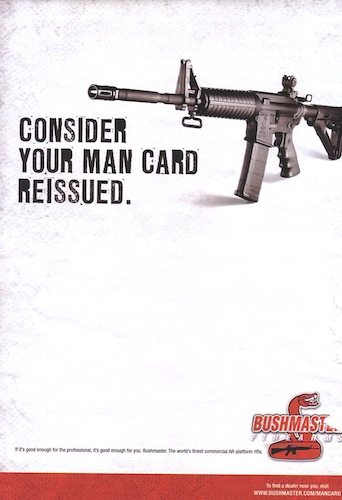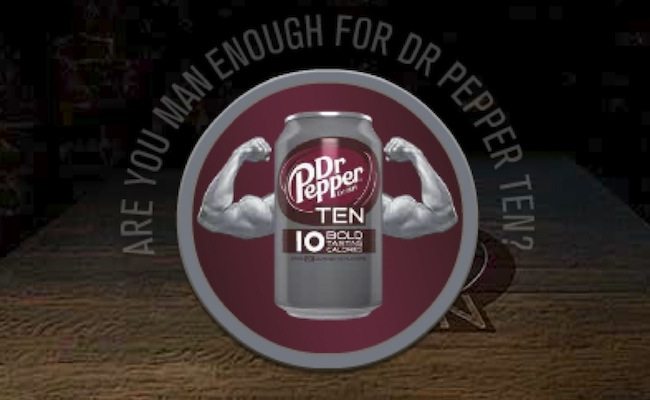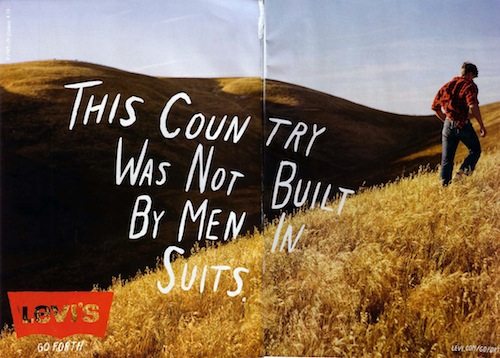Trigger warning: This post contains images that strongly imply violence against women and rape.
Originally published at Doctor NerdLove, and cross-posted here with their permission.
The topic of masculinity is one I come back to over and over again because it’s a long-running question for many men.
The search for an identity and finding one’s own definition of what it means to be a man is an important part of maturity for young men, one that has been with us through most of recorded history.
The question of the role and meaning of masculinity is especially strong in younger men – men in their late teens and early twenties – as they strike out to find their own place in the world.
It’s only natural to look to the world around us for gender cues and role-models to guide us through the thorny questions of gender identity (by which I mean the definitions of masculinity and femininity, not whether a person identifies with the gender of their birth) and the role to take in the world.
With the ubiquity of mass-communication – whether it be magazines, newspapers, movies, television or the Internet – it’s not surprising that many men look to popular culture for sources of information what male behavior is supposed to be and how we’re supposed to display it.
Unfortunately, mass media doesn’t send the greatest of messages about how to be a man. In fact, we are regularly bombarded with messages selling the idea that masculinity is violent, physically aggressive and sexually domineering and that anger and stoic toughness are the only appropriate emotions for men to display.
Male-oriented advertising is targeting young and impressionable men looking for guidance… so it’s time to take a look at just what they’re selling.
Manhood For Sale
Amanda Hess’ article in Slate Magazine alerted me to a study examining just how masculinity is pitched to young men. In the most recent issue of the journal Sex Roles, psychologists from the University of Manitoba examined the prevalence of hypermasculinity – the ideology of exaggerated male traits as the epitome of masculine identity – in advertisements in popular men’s magazines including Maxim, Playboy, Game Informer, Fortune, Esquire and Wired.
Hypermasculinity portrays violence and physical aggression as manly ideals; it promotes a world where all of male life is a struggle of dominance of others, where sex is a matter of power and female submission rather than one of intimacy and mutual pleasure and that any “feminine” emotions are to be repressed.

Seriously, Freud would be having a field-day here.
The researchers kept track of ads that fit into the definition of hypermasculine – ads that showed men as violent, physically aggressive, hypersexual or participating in “dangerous” activities for the thrill of it all – and cross-referenced them with the demographics that the magazines targeted. For those of you who like to crunch the math, the methodology can be found in the report – it’s a tad involved but the end results were interesting.
Over half of ads in men’s magazines presented over-the-top imagery from hypermasculine ideology – upwards of 90% in some magazines like Game Informer.
Moreover, hypermasculine imagery was predominantly aimed at two audiences: younger men (adolescents and men in their early 20s) and older working-class men without college educations.
These two groups were, in many ways, the most easily influenced. Neither have much in the way of disposable income; in fact, a higher income level of the magazine’s target audience correlated with fewer ads depicting exaggerated male behavior.
Younger men are more often the ones seeking out their identity. They are more likely to look to others for ideas of gender presentation, and thus they are the ones whose behavior is more likely to be influenced by media and reinforced by their peer group.
Meanwhile, the blue-collar workers tend to be ones who feel disempowered and disenfranchised by society; they are more likely to lack popular indicators of social value such as financial success or social influence.
As a result, they are more likely to look for alternative means of gaining respect and influence from one’s peers – physical toughness, macho behavior, violence and aggression.
In both cases – the youth and the working-class men – are looking to fill a void. The younger men are trying to find their place in the world and are seeking guidance as they work towards how to be men.
Meanwhile the older men are often feel as though they have been cheated and that others are benefiting from something that’s being denied to them, thus they want to re-establish their manhood.
Advertisers are well aware of this and craft their message with supposed ideals of masculine identity; “Feeling insufficiently manly?” they ask. “This product will make you the man you’ve always known you could be.”

They also say “Everybody get ready for the rape train!”
Marketing and the Gender Police
Genderads – where I’ve found most of the examples I’ve used in this article – is a reponsitory of hypermasculine imagery in advertising… and it’s genuinely disturbing to visit. It drives home just how often we’re sold on the idealization of these masculine stereotypes.
When the imagery becomes as prevalent as it has, it almost becomes subliminal; we know it’s there and what it’s saying but we don’t consciously perceive it.
It has become the background noise of our day to day lives that we absorb it passively, without thinking about the context or what messages it sends.
Hypermasculine ideology reinforces a culture that permits a very narrow expression of male identity. The message carried by the imagery is that men are defined by conflict and violence.
Every interaction between men is one of a struggle for dominance. There are no equals, only the dominant and the submissive.
Women, on the other hand, are things. They are to be desired, yes, but not as partners or equal participants in life; they are trophies, proof of one’s superior masculinity.
The men in these ads don’t value the women for their personality, their minds, their ability to make them laugh… they are at best ornamental.
At worst, they are playthings – pets even – to be used however a man cares to, regardless of their wishes.

Someone else is going to have to explain an ad that screams “Is Daddy going to have to choke a bitch” is relevant to selling sunglasses.
Someone else is going to have to explain how “Is Daddy going to have to choke a bitch?” is relevant to selling sunglasses.
Moreover, it’s important that women are implied to be for men’s sexual use at any time. Men, you see, are hypersexual.
To be a man is to be a satyr, rampantly virile and voracious in appetite. A man is defined by his steely hard-on as much – if not more – than by his muscles or his toughness.
A man is ready to fuck in a bare instant. If you aren’t able to have an erection so hard that you could fuck concrete in the blink of an eye… well shit son, you’re just not a man.

SUBTLETY!
Mind you, these are very strict heterosexual standards. The story of manhood in these messages is one of a very narrowly defined form of heteronormativity; to deviate even slightly from this model of manhood is to be feminine, which is a fate worse than anything short of emasculation.
The constant underlying subtext is that if you don’t meet the implied definition of manliness, you’re a fag; you have given up your identity as a (dominant) male to take on the subservient, female role.
In this ideology, being gay is almost worse than being a woman, since it’s a man choosing to be penetrated – and thus, dominated – rather than the one in charge.
To not be in absolute control is to be lesser. Anything with a whiff of femininity – including the expression of any emotions (besides anger or stony indifference that is), caring about one’s appearance or even drinking the wrong beverages – is to be violently repressed.

“This ain’t no soda for no queers!”
In addition, the life of a man is a physical one, with minimal investment or worth given to any life path that doesn’t involve hunting, ranching or building.
There is, in fact, a distinct anti-intellectual thread to the ideology of hypermasculinity; men live lives of action and thrilling danger. Those thinkers with their “refined” tastes and “office” jobs are the betas to the rough-and-tumble alphas.

You know what else it was never followed by? “GET YOUR DAMN HORSE OUT OF MY SALOON!”
The point of the intellectual or the “suit” is to give way to the real men, the ones who do the real work.

Underlying all of these messages is an implied threat: be a man…or else. Anything less than the pinacle of the manly ideal is seen as grounds for punishment – being exiled from the company of men, denied the fruits of masculinity, or even violent reprisal.
The Consequences of the Cult of Manliness
It is tempting to write all of this off as someone trying to create a problem where there is none. These are, after all, just advertisements; nobody looks at an ad for Diesel jeans or sunglasses and suddenly decides to go out and smack around some bitches, right bro?

Seriously, what the fuck is this even supposed to be selling?
Ads by their very definition are designed to influence you; the whole point of advertisements is to sell products and services – in this case, by equating said products or services with over the top stereotypes of the “ideal” of masculine identity.
They serve as a socializing agent, spreading those ideals through continuous exposure.
The constant stream of imagery may not directly establish the social norms for masculinity but theydo reinforce the belief, just as pop culture continually portraying African-American males as thugs, thieves, drug dealers, and murderers reinforces already extant racist stereotypes.
The continuous social reinforcement of the hyper-masculine ideal in marketing helps internalize the belief that this is how men should be.
And yet, those very same beliefs have profoundly negative effects on men and in society. Studies have found that hypermasculinity is correlated with physicaly abusive relationships and sexual aggression against women. Prisoners convicted of violent crimes were also found to have a high hypermasculinity index.
The perpetuation and reinforcement of men as sexually dominant and women as passive, impersonal receptacles contributes to the rape culture that insists that men are unable to control their own sexuality and thus it is the duty of women to not be raped.
When Zerlina Maxwell went on the Sean Hannity show on Fox News, she proposed the “radical” idea that rather than arming women, the appropriate way to help end rape and sexual assault was to end a culture where men are taught that they have no responsibility.
The result was immediate and – sadly – somewhat predictable.
Maxwell was insulted, belittled and subject to continual harassment because “rapists just aren’t going to listen.” But that presumes that all rapists are strangers, assaulting women from the bushes.
Most rapists aren’t strangers; they are men who grow up to believe that – as in the Stubenville rape case – “not saying no” is equal to a de-facto “yes”.

On a basketball court: fashion marketing. In Uncle Touchy’s basement: People’s Exhibit A.
Consider that Game Informer is a magazine aimed at a young audience. The price of gender non-compliance amongst young men can be harsh and often violent – thus they are already incentivized to believe that they too need to be suitably “tough”and “manly” or risk being ostracized, bullied or even assaulted.
The barrage of messages helps confirm and reinforce the hypermasculine ideal that men are to be dominant and aggressive, that sex is something that is available to you by default and that take not “no” for an answer is a good thing.
It fortifies a culture where boys think that it’s ok to take a girl who is intoxicated to the point of near unconsciousness, carry her limp body around, penetrate her, try to force her to perform oral sex and then urinate and ejaculate on her… and then express regret only that pictures were taken and shared with others.
Even worse, the culture teaches bystanders not to interfere – because boys will be boys after all – and for other men to actively enable their crime by placing the blame on the victim.
Don’t get me wrong: nobody is suggesting that Game Informer or Playboy are responsible for men becoming rapists.
But they are influences on the social ideals of masculinity and the development of these attitudes and we need to be aware of the messages they market to us.
The Insult To Men
There will no doubt be the wags – mighty armchair warriors, they – who will insist that these are the complaints of a “beta” who is whining about the macho assholes who stole his girlfriend. More power to them if they choose to believe this.
I, on the other hand would like to know why they don’t find any of this insulting.
The vision of manhood perpetuated by the hyper-masculine ideology is one where men are little better than chimps.
The world of hyper-masculinity is one where life is brutish, stupid and short. All male interactions are a forms of aggression and dominance display; “toughness” masquerades as discipline and male friendships cannot exist because emotional intimacy are frowned upon for fear of being too feminine.
Men in this ideology are disconnected from their emotions – love does not exist except in the desire for material goods (a man’s love for his truck) or one’s pet (a man’s love for his dog).
Women are not equals; they are measuring sticks for one’s worth – except for when they become dominant over men, at which point they become threats to masculinity.
A man in this ideology has next to no control over his impulses. He is ruled by his genitals and his need to gain the respect of others through violence and the pursuit of danger. He is utterly at the mercy of his base instincts: the need to fuck, the need to eat, the need to accumulate goods.
He is powerless to resist them and logic, restraint, and rational thought all fall by the wayside. If these are the values that you think define what it means to be a man… well, you are sad, strange little beings and you have my pity.
Moreover, the ads conflating these ideals are telling you that manhood is virtually worthless! By tying masculine power, respect and manhood to commerce, you strip the value from it. What prize is there to manhood when it no longer has to be earned or built from the ground up?
What value is there to be had when manhood can be purchased, rather than earned through sweat, fear, perseverance, determination, growth, courage and experience? Who is truly a man when manhood is no longer won but sold?
Personally, I value being a man too much to let it be insulted, marginalized and commodified like this.
And so should you.
[do_widget id=”text-101″]
Dr. NerdLove dispenses love, sex and life advice for geeks, otaku, dweebs, poozers, nerds and the occasional neo-maxie-zoom-dweebie. Read his blog, Paging Dr. NerdLove, follow him on Twitter @DrNerdlove, or like his Facebook page.
Search our 3000+ articles!
Read our articles about:
Our online racial justice training
Used by hundreds of universities, non-profits, and businesses.
Click to learn more





















